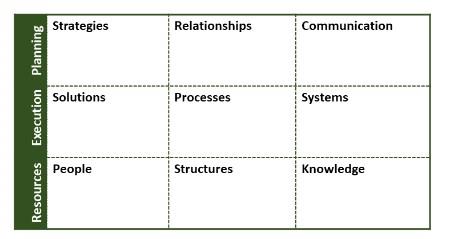by Christoph Senn*
When was the last time you took stock of your business relationships? Are they stuck in a one-sided, transactional mode? Or are they continuously exceeding both parties’ expectations?
A typical business setting, where a company provides “value” by peddling its existing products and services to its customers, is essentially a one-sided affair. Without critical customer input in creating value, this business-as-usual approach seldom delivers a comprehensive, mutual strategy.
Similarly, in developing account plans for corporate customers, businesses are prone to focus mainly on sales history, the competitive landscape, and a future sales pipeline. But these narrow discussions on tactics and pricing tend to miss the larger issues of strategy, and more importantly, collaboration.
From selling to co-creating
In the traditional “value selling” approach, suppliers start by identifying customers whose needs best fit their products and develop a value proposition targeted at these customers. The tactic is focused on what a company’s products can do for the customer. However, the two parties should in fact be focused on creating value together. A good starting point is to ask the question: “What would we do differently, if we were one company?”
Studies of over 3,000 relationship cases show that only 15 percent of frontline sellers work with their clients based on this one-company mindset. By co-creating value, they could have doubled their account value in three years on average. Similarly, senior managers who adopt a customer-centric, value-creating perspective could have increased sales and profitability at twice the rate of their peers. Unfortunately, at 14 percent, they are but a minority of senior managers.
So, what are the building blocks of successful business relationships? How can companies create future-proof relationships that will survive times of uncertainty?
In research conducted from 1997 to 2020, I identified theoretical and empirical answers to those questions: Good business relationships have nine critical building blocks. And enduring relationships depend on strong collaboration between suppliers and customers. On the basis of that research, I developed the triple fit canvas, a framework designed to facilitate collaborative value creation between sellers and buyers.
This diagnostic and action framework was inspired by the blue ocean strategy canvas developed by INSEAD Professors W. Chan Kim and Renee Mauborgne and the business model canvas developed by Alexander Osterwalder and Yves Pigneur. By extending a limited, product-centric view to a broader, customer-centric perspective, it shifts the focus from selling existing products and services to helping create new opportunities for mutual growth.
It all starts with a conversation
High-performing business relationships start with broader conversations about how to help clients create value, instead of trying to fit existing products into an existing strategy. These conversations involve “What can we do to improve the relationship?” or “What are our combined strengths and weaknesses?” Using this framework, I have worked with companies such as Maersk, Konica Minolta, and Thermo Fisher Scientific, who have benefitted from this approach.
When health, nutrition and bioscience company DSM discussed areas for value creation and collaboration hurdles with its dairy producing customer, it aligned with the customer’s mission to become the leader of an all-natural organic product. As a result, DSM doubled the value of the dairy producer’s pilot programme and improved its client revenue by nearly €1 million in less than a year.
In the case of telecommunications company Vodafone, a triple fit analysis with a major bank to identify value deficits revealed the need to prepare the bank’s technology for the future of mobile banking. This led to the development of a game plan, which resulted in Vodafone’s business with the bank increasing by 11 percent annually over the next three years and an increase of its opportunity pipeline by 30 percent.
Apart from deepening existing relationships, the framework can also open opportunities for potential relationships, as Schindler Group, a manufacturer of escalators, walkways and elevators, did. Productive conversations between Schindler and its prospective customer, a multinational construction, property and infrastructure company, led to cost-saving initiatives, improved product quality and increased safety levels. In two years, the infrastructure company saved more than US$16 million. As a result, not only was Schindler awarded a large portion of its business, it was also granted full visibility into its customer’s ten-year project pipeline.
Building blocks of the triple fit canvas
The triple fit canvas is a business framework designed to facilitate collaborative value creation between sellers and buyers. Triple fit takes a holistic view and prioritises value creation across three collaboration fit levels: planning fit, execution fit and resources fit. In essence, there are nine key components across these three fit levels (see figure 1).

First, planning comprises three building blocks: strategies, relationships and communication. It involves the alignment of a company’s strategic direction with the customer’s and developing a joint three-year vision. At this stage, building and maintaining multilevel contacts can promote stable relationships and facilitate communication of relevant information to customers for effective decision making.
Next, effective execution of the joint strategy requires mastery in three building blocks: solutions, processes and systems. It involves the development of solutions and services that create value for customers, efficient execution of processes along the value chain, as well as the implementation of systems for IT, finance and legal support.
Finally, the resources fit consist of people, structures and knowledge. Suppliers need the necessary resources to support customers, including customer-centric advisers, a customer-centric organisational structure and a dynamic learning environment to generate new business.
Evonik Industries, a German specialty-chemicals group, used an early version of the triple fit canvas in 2006 to integrate the perspectives of its 300 biggest customers into product development and its go-to-market strategy. The joint value creation initiative involved innovation workshops with customers to determine what such integration would look like for each customer, translating those insights into tailor-made three-year-growth roadmaps and validation of the plans by customers.
A better understanding of each party’s capabilities and ways to complement each other paved the way to Evonik signing a €150-million deal with one of its largest automotive customers six months later. The process also helped Evonik to weather the 2008 financial crisis better than its competitors did.
Five steps to unleash the power of co-creation
In practice, performing a triple fit process involves five steps.
Step 1: The relationship maturity check
First, determine how well your company collaborates and communicates with its customers by rating ten statements about its relationship with each customer. Rate each of these statements about your company from your customer’s perspective, on a scale of 1 (disagree completely) to 5 (agree completely).
1.Overall, we rate our relationship with (your company) as
2.(Your company) uses a mutually-agreed-upon collaboration strategy with us
3.(Your company) maintains strong contacts, from the operational to the executive level, with us
4.(Your company) communicates in an open, fair and forward-looking way with us
5.(Your company) develops unique offerings and value propositions for us
6.(Your company) aligns processes effectively and efficiently along our value chain
7.(Your company) does business with us using compatible IT, finance and legal systems
8.(Your company) assigns people with the ability to act as trusted advisers for us
9.(Your company) provides cross-functional organisational and support structures for us
10.(Your company) uses its knowledge to co-create new, profitable business for us
To overcome self-reporting bias, involve your customers to rate the statements as well. Sharing your findings with customers not only serves to validate your assessment, but will also lead to aligned priorities and strategies.
Step 2: Identify areas for improvement
Based on the relationship maturity check, identify strengths that led to a high rating or weaknesses that prevented one. In areas where rating is low, ask why (up to five times) to identify the root cause, with the help of your customers.
Step 3: Develop viable solutions
With the results from step 2, explore ideas to boost value and mitigate risk. Start by asking what needs to be done to improve (or maintain) the situation, without jumping to conclusions (or actions) too quickly. Start by mapping the range of reasonable options, prioritise and select the most promising ideas, and validate their plausibility with the support of relevant stakeholders.
Step 4: Distinguish between long- and short-term actions
Then, group value-creation ideas into quick-win actions in the form of 90-day projects and longer-term initiatives of up to three years. To garner stakeholder support, describe exactly how each action will be executed and deliver value, including a robust estimate of investment and return.
Step 5: Get your stakeholders onboard
Finally, consolidate and summarise your triple-fit findings and pitch the central message to stakeholders. Efforts should be put into aligning product-minded salespeople to shift to big-picture thinking and collaborative value creation. At the management level, persuade senior leaders to adopt your central message, provide funding for your initiatives and accept both the benefits and risks.
Look for value in the right places
While insights from historical customer data are important, they can hardly unlock innovation like co-creation with customers can. As the previous examples have shown, developing a joint value-creation strategy with customers does not only help companies to identify where they have struggled, but also helps to identify opportunities for future innovation and growth.
When Maersk tried to win over the Gap account from its competitor, it conducted a triple fit process with Gap. As part of the analysis, a closer study of Gap’s cash flow revealed opportunities for savings by reducing Gap’s inventory, discounting obsolete clothing lines and shortening lead times, while increasing Gap’s speed to market. As a result, they developed initiatives that unlocked significant value and reduced Gap’s logistics costs by more than US$25 million during the pilot phase. Within two years, Maersk increased its revenue and profitability by 300 percent.
Ultimately, results show that working with customers based on the mindset of “what if we were one company?” is the surer path to unlocking new sources of value. When revisited quarterly, the triple fit canvas not only helps companies to align their activities, it also helps them to keep the momentum and creates a significant difference to competitor approaches by moving beyond a product-focus to the full range of value creation.
*Adjunct Professor of Marketing at INSEAD and Co-Director of the INSEAD Marketing & Sales Excellence Initiative
**first published in: knowledge.insead.edu




 By: N. Peter Kramer
By: N. Peter Kramer

